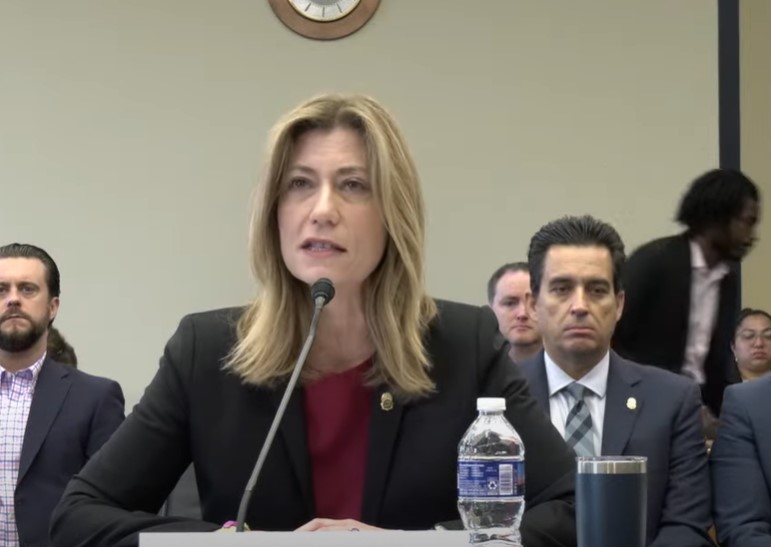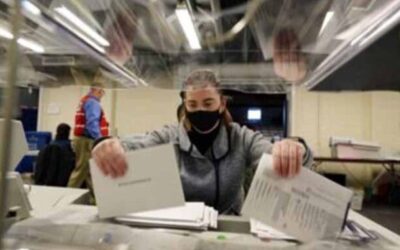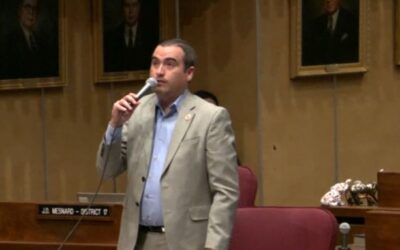By Corinne Murdock |
The head of the Drug Enforcement Administration (DEA) is making no promises on a timeline to come clean on the agency providing intelligence and resources to a known Sinaloa Cartel drug trafficker.
After avoiding any commitment to offering any self-imposed deadlines on providing records on the aid, DEA Administrator Anne Milgram told lawmakers that she could only give them “hope” and her word for answers.
“I will give you hope, and I will tell you that I will prioritize it,” said Milgram.
The exchange with Milgram occurred during Thursday’s House Judiciary GOP hearing on oversight of the DEA. Rep. Andy Biggs (R-AZ-05) led the hearing and the line of questioning concerning the trafficker: former Mexican secretary of public security Genaro García Luna, who was convicted of his crimes in January.
Biggs asked for a follow-up on Sen. Chuck Grassley’s (R-IA) two letters sent February and June to the DEA and FBI requesting records on García Luna. Grassley requested recordings of García Luna with dates of their creation and when the DEA became aware; all reports, notes, and other documents relating to García Luna’s criminal activity; content from García Luna’s cell phone and laptop; a detailed explanation of what, when, and how the FBI and DEA knew about García Luna’s corruption and criminal activity; the vetting the FBI and DEA conducted of García Luna, and the persons responsible; and all trial transcripts and exhibits from United States v. García Luna.
“Ignoring Congressional oversight questions relating to the Sinaloa cartel and foreign corruption demonstrates a lack of commitment to bringing criminals to justice,” wrote Grassley in his June letter.
Biggs also asked for copies of the records. Milgram promised to “check on the status of the letter[s].” Biggs then requested a “self-imposed action-item deadline” for the committee, to which Milgram indicated she had no idea how long it would take for the DEA to coordinate with the Department of Justice (DOJ) on obtaining the records.
Biggs pressed again for a timeline, to which Milgram said she could only give him “hope” for answers.
The U.S. Embassy reportedly knew of García Luna’s corruption before receiving a 2008 report filed by a Mexican police commander. The embassy informed the commander that the U.S. was already investigating García Luna. A week later, the commander was arrested and tortured; he was imprisoned for four years before being released.
In 2010, the DEA learned from a key cartel witness that García Luna accepted money from the cartel.
García Luna remained in office until 2012, and wasn’t arrested until December 2019.
Even with ongoing investigations, the federal government provided patrol cars used to transport cocaine, as well as training and equipment for García Luna’s officers who were trafficking the cocaine.
Milgram’s hesitancy to issue a stricter timeline for the records may be related to the ongoing investigation into the administrator for allegedly not having clean hands herself.
The hearing opened with brief acknowledgement of the allegations against Milgram concerning investigations of millions of dollars in outside, no-bid contracts to hire former associates.
The remainder of the hearing focused on DEA efforts to counter and disrupt drug trafficking.
Nearly 100,000 overdoses occurred last year. Drug overdoses, specifically fentanyl overdoses, are the leading cause of death to those aged 18-45. Chief among the increase in overdoses is fentanyl. This type of overdose accounted for 84 percent of overdose deaths in teens.
Milgram described the current drug epidemic as “nothing we’ve ever seen before” — a crisis of unprecedented proportions — and identified fentanyl as the cause. She reported the DEA has developed two counter-threat teams to defeat the primary fentanyl traffickers: the Sinaloa and Jalisco cartels, both based in Mexico.
“One drug, fentanyl, has transformed the criminal landscape,” said Milgram. “We are actively targeting every aspect of the global fentanyl supply chain.”
A mere two milligrams of fentanyl, equivalent to a few grains of salt, can be lethal. Milgram described fentanyl as cheap to make and easy to disguise as other drugs in order to drive addiction.
In April, the DEA identified the Chapitos network of the Sinaloa cartel as the pioneer and primary manufacturer and trafficker of fentanyl into the U.S. Chinese suppliers, manufacturers in Mexico, and U.S. distributors. 28 members and associates were charged; nine were taken into custody.
In May, the DEA publicized their results of Operation Last Mile: the arrest of 3,337 associates of the Sinaloa and Jalisco cartels operating within the U.S. Milgram reported that they rely on social media and encrypted messaging apps for their trafficking.
In June, the DEA announced the outcome of Operation Killer Chemicals: three cases charging four Chinese chemical companies and eight Chinese nationals, four of whom are in custody, with supplying precursor chemicals and scientific knowledge of creating fentanyl. Milgram reported that these charges marked the first of their kind.
Milgram also confirmed that DEA agents are stationed along the southwest border, and in Mexican plazas. Biggs asked what DEA’s role in interdiction at ports of entry along the southwest border; Milgram clarified that the DEA focuses on the border to some degree, but noted that their work covers a global scale.
Biggs indicated that cartels have an easier time trafficking drugs across the border between ports of entry, citing his past solo trips to the border where he could drive for miles without encountering any Customs and Border Protection (CBP) agents.
“Not most of it comes through ports of entry, you would agree with me that most of it comes through between ports of entry where we don’t have any personnel, we don’t have the one-on-one, we don’t have the capacity to interdict between ports of entry,” said Biggs. “I think too many times people think because we seize a lot at the ports of entry, we forget that there’s a massive, wide open border.”
Milgram didn’t deny Biggs’ statement that most of the trafficked drugs come between ports of entry.
Watch the full hearing here:
Corinne Murdock is a reporter for AZ Free News. Follow her latest on Twitter, or email tips to corinne@azfreenews.com.








